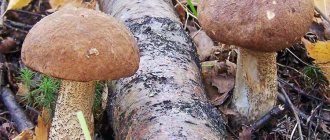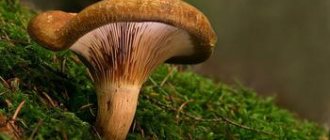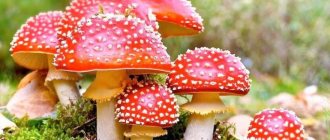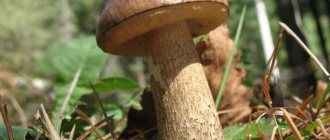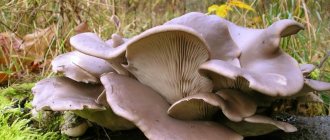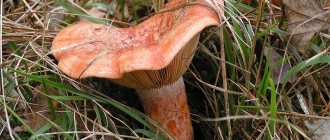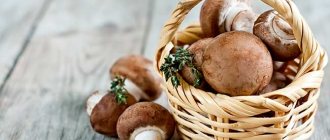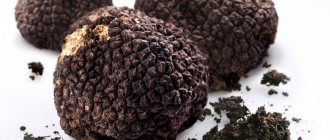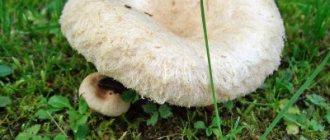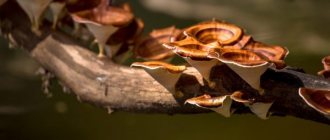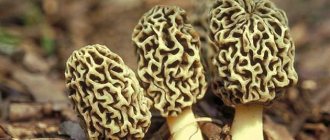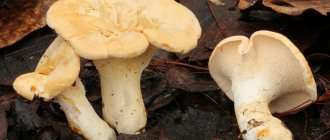Characteristics and description
The description of plum mushrooms is well known to experienced mushroom pickers, but novice mushroom pickers collect this species quite rarely:
- garden entoloma has a cap, the diameter of which varies between 70-120 mm;
- young specimens have a bell-conical or convex cap, which with age becomes unevenly spread and convex-concave;
- quite often there is a tubercle on the cap of adult mushrooms;
- the surface of the cap is smooth and slightly sticky in rainy weather;
- during the dry season, the cap is of a silky-fibrous type, with uneven wavy edges;
- The color of the cap, depending on the age of the fruiting body, can vary from white-gray, beige and gray-brown;
- on the reverse side of the caps there are wide type, sparse and adherent plates to the stem;
- young entoloma is whitish or soft gray-pink in color, but with age the fruiting body acquires a reddish color;
- the leg is cylindrical, can be curved or twisted, up to 10-12 cm high and up to 30-40 mm thick;
- the leg is characterized by fragility, longitudinal ribbedness, and complete absence of a ring;
- coloring of the leg is whitish, pinkish-gray or grayish.
Safety rules for “silent hunting”
To avoid picking poisonous mushrooms and prevent poisoning, you should adhere to the following recommendations:
- Do not pick mushrooms growing near factories, highways, or railroad tracks.
- Do not cut off old and wormy mushrooms, as well as those growing nearby poisonous ones.
- Don't eat mushrooms raw.
- Don’t pick mushrooms that you doubt are edible, or better yet, don’t even touch them.
- Cut off all mushrooms with stems: they can be used to ensure that the mushroom is not poisonous.
- Harvest in wicker baskets to keep them fresh longer.
- Do not handle poisonous mushrooms, and use gloves to protect yourself from accidental contact.
- Do not allow children to touch any mushrooms without adult permission.
Similar types of mushrooms
There are edible and inedible varieties of mushrooms quite similar to Entoloma clypeatum. Among edible mushroom species, the pale brown entoloma, or Entoloma sepium, is of particular interest . This mushroom has a cream, brownish-gray or grayish-brownish-green cap with the presence of notched-descending plates and a white, shiny surface, long-fibrous stalk. The edible species Entoloma sepium, similar to the plum plant, most often grows on lawns and garden areas, as well as under bushes from the last ten days of May to mid-June.
It is important to note that in addition to the edible species of entoloma, poisonous or tin entoloma grows on the territory of our country. The main, very characteristic difference of the poisonous Entoloma sinuatum is its larger cap. The average diameter of the cap of an adult mushroom often reaches 18-19 cm. The surface of the cap is off-white, creamy-gray, grayish-ocher and yellowish in color. There is a removable skin and yellowish color, rather thick plates. The leg is club-shaped, the same color as the cap. The pulp has a not too pronounced, but faint odor.
In addition, in our country there may be not very common, but, nevertheless, highly poisonous species, including crushed Entoloma or Entoloma rhodopolium, which has a thin yellowish-cream, gray or brownish cap and an ammonia aroma. It grows from the last ten days of summer until the steady autumn cooling. The inedible spring entoloma is characterized by a darker coloring of the fruiting body, small size and slender stalk.
A culinary discovery for true connoisseurs - Garden Entoloma
Translated from Latin, the name of this mushroom means “shield-shaped.” Garden entoloma is an edible species of the entoloma family, which has many varieties, including both simply inedible and poisonous ones. Therefore, in order to collect entholoms for food purposes, you need to understand them very well.
Description and characteristics of a conditionally edible mushroom
The mushroom has other names: Entoloma garden, forest or thyroid. Latin name: Entoloma clypeatum. A species of mushroom in the Entoloma family, genus Entoloma.
Also called: Rozovoplastinnik thyroid, Entoloma edible, Entoloma shield, Entoloma blackthorn, Podslivnik, Podabrikosovik, Podzherdelnik.
The diameter of the mushroom cap varies from 2 to 12 cm. In young specimens it has a conical or slightly convex shape, but with age it becomes almost flat with a wide tubercle in the center. As the mushroom ages, the cap cracks at the edges.
It has a dark brown, gray-brown or red-brown color, sometimes with an olive or buffy tint. After rain, the surface of the cap becomes sticky. The lower part of the cap - the hymenophore - has a lamellar structure. The plates are located close to each other and attached to the stem.
Young mushrooms have a white or grayish hymenophore; with age, the color changes to pink or brownish-pink.
The pulp of entoloma is white in color with a specific mealy smell and taste.
The stem is white in color, sometimes with a grayish or brownish tint, reaches 4-9 cm in height and is about 2 cm thick.
A little history
The gradual study of the extensive genus of entholomas began at the end of the 19th century and has not stopped since then. Scientists are discovering more and more new species.
The first description of Rozovoplastinnik was prepared by mycological researchers at the Botanical Institute named after. A.N. Severtsov RAS in the 70s. XX century.
Time and place of fruiting
Habitat: Western Europe, North America, the European part of Russia and Ukraine.
Rosewort is widespread. It can be found in mixed and deciduous forests, next to birches, rowan trees and oaks.
Mushroom pickers find garden Entoloma in meadows and gardens under fruit trees. The ideal neighborhood for her is pear and apple trees, as well as rose hips, blackthorn, hawthorn and rose bushes.
Podslivniki can be found everywhere in the Stavropol Territory - even along roads and on lawns, the only important thing is the presence of nutritious fertile soil.
Fruiting time is from May to the end of July. Usually grow in groups.
Important! In your personal garden plot, you can expect a large harvest of entoloma if you do not cut it for three seasons in a row.
False doubles
Entoloma has a fairly large number of doubles. You can clearly see the differences in the photo.
- Pale brown entoloma is also an edible variety. It is similar to the garden plant due to the same color of the legs and cap.
- Collectable entoloma is distinguished by the presence of shiny scales and the fact that the stem expands towards the base.
Dangerous twins:
| Entoloma poisonous or tin | The main difference is the large cap compared to Podslivnik. Its diameter can reach 2 cm. The skin is easily removed, the plates are yellowish in color. Has almost no smell. In order to get severe intoxication, it is enough to eat one small piece. The first signs of poisoning appear within half an hour after eating the mushroom. |
| Entoloma crushed | The fruiting period differs from the garden - from August to October. It can also be distinguished by its pungent ammonia smell. |
| Entoloma spring | It has a different fruiting period from Podlivnik - from April to May. It also stands out due to its darker cap color and smaller size. |
Important! Poisoning can manifest itself with a wide variety of symptoms: long-lasting migraine, dizziness, loss of coordination, nausea and vomiting, diarrhea and flatulence, weakness in the body. If at least one of the listed symptoms is observed after eating entoloma, you should immediately consult a doctor.
Evaluation of taste qualities, primary processing and cooking recipes
The mushroom is classified as conditionally edible. Requires preliminary preparation. Entoloma is first boiled for 20 minutes and only then fried, pickled or salted.
In Russia, dishes from garden entolomas are not very popular, but in Western Europe these mushrooms are popular.
How to cook a roast?
Ingredients:
- entoloma – 800 g;
- red onion – 2 pcs.;
- tomato sauce – 3 tbsp;
- garlic – 2 cloves;
- lemon juice – 1 tbsp;
- salt, sugar - to taste.
Preparation:
- Fry the pre-boiled mushrooms.
- Separately, fry the red onion until half cooked.
- Mix tomato sauce, finely chopped garlic, lemon juice, salt and sugar and fry a little.
- Mix all ingredients and let it brew.
Pickling
Ingredients:
- mushrooms – 3 kg;
- table salt – 120 g;
- dill (greens, inflorescences or seeds) - to taste;
- black pepper – 30-35 peas;
- bay leaf – 6 pcs.;
- garlic – 4-5 cloves.
Cooking method:
Pre-boiled mushrooms are placed in a pickling container with all other ingredients in the following order:
- Place bay leaf, chopped garlic and dill, as well as black pepper on the bottom.
- Place mushrooms on top of the spices in a layer of about 7 cm and sprinkle with salt.
- Add a few more layers to the edge of the container.
- Cover the workpiece with a napkin, place a weight on top and put it in a dark place for a month.
- After the required time, the pink plates will be ready for use.
Marinovka
For preparation you will need:
- 0.5 kg of boiled mushrooms;
- 80 g apple cider vinegar 5%;
- 120 g vegetable oil;
- 2-3 cloves of garlic;
- 10 black peppercorns;
- 1 tsp salt;
- 2 tsp Sahara;
- 4 things. bay leaf.
Cooking method:
- Press the garlic through a press.
- Place all ingredients in a deep frying pan, cover with a lid, place over medium heat and simmer for 10 minutes.
- Cool, transfer to a jar and refrigerate for 4 hours.
When and where do they grow?
Podlivniki are traditionally mistakenly classified as southern mushrooms that grow in deciduous and mixed forest zones. Most often, the fruiting bodies of Entoloma clypeatum grow under rowan trees, birch and oak trees, on nutritious soils. Many novice mushroom pickers, guided by the name of this mushroom, believe that the fruiting bodies of the plum plant grow exclusively under the plum tree. However, such a statement is not true.
In spring, plums can appear along roads, as well as in meadows and under garden plantings. In garden plots, mushrooms often grow under apple and pear trees, under rose hips, hawthorn or blackthorn. This type of mushroom is widespread in the Leningrad region, and mass fruiting in several layers is observed from May to July. Plums often grow in large and small groups.
May row, edible or not?
Only beginners who do not understand the families of the mushroom world can call the May row inedible. Experienced mushroom pickers do not ask this question, knowing for sure that despite the unusual taste, which not everyone likes, the mushroom is edible and healthy after heat treatment and cooking. The composition of the fruit is similar in value to offal: beef and pork liver, chicken gizzards and heart.
Interesting!
The mushroom contains a high content of chitin, which removes accumulated poisons and toxins from the body. The substance has a beneficial effect on the functioning of internal organs, renewing tissues and rejuvenating the membranes. In addition, spring rowing contains many antioxidants that affect mental activity. The substance is a prevention of cancer.
How to cook properly
As a rule, the stems of the fruiting plant are not used for food purposes, which is due to the excessive rigidity of this part of the fruiting body. The fruiting bodies of Entoloma clypeatum can be fried, used in soups, and preserved for the winter by pickling. The collected mushrooms should be carefully sorted and washed , then thoroughly cleaned and boiled until tender. Mushrooms that have undergone such preliminary preparation can be fried or used for other cooking methods.
Entoloma clypeatum is also very suitable for use in pickling and pickling. In this case, preliminary soaking is not required, but the boiling process is mandatory. Salting can be carried out either by a long-term method according to a traditional recipe using pressure and salting for 30-40 days, or by a high-speed method according to a recipe for preparing russula. For this purpose, you need to boil the previously prepared fruiting bodies a couple of times, then rinse and fill with clean water, cook for about an hour, then add salt and add chopped garlic, as well as dill seeds. The mushrooms are placed under pressure and placed in the refrigerator for a couple of days, after which the dish will be completely ready to eat.
Video gallery
Video reviews
A selection of videos with descriptions and recipes for preparing mushrooms
Mushrooms of Ukraine / Mushrooms of Ukraine, GRIBOED, about Mushrooms and Plants in Your Own Words
Smoky talker
It can be distinguished from other similar mushrooms thanks to its characteristic whitish or creamy plates that can be easily removed from the cap. It has a pronounced odor, similar to floral, fruity or mealy, which is not always pleasant. During cooking it intensifies significantly. The mushrooms taste spicy with a sweet or sour aftertaste.
Smoky talker mycorrhizes with spruce, oak, and birch trees. You can meet them on the outskirts of the forest, in gardens, but always next to wet, rotting branches. Grows in groups, rows or circles. Fruiting lasts throughout the fall.
Treatment for poisoning
If you are poisoned by a poisonous mushroom, the first thing you need to do is call an ambulance. In this case, the patient is taken to the hospital for further hospitalization, and the remains of the mushrooms are taken for examination to the laboratory to determine toxicity.
The hospital provides the following assistance in case of poisoning:
- Flushing the stomach with plenty of warm, slightly salted water in order to remove remaining toxins from the body that have not yet been absorbed into the blood or passed from the stomach to the intestines. To do this, drink a large amount of water, and then artificially induce vomiting, the procedure is repeated several times.
- The intestines are washed with an enema with rehydron or a small amount of table salt. The procedure is also repeated several times.
- Absorbents are given that neutralize the effects of fungal toxins.
- If diarrhea has not yet begun, the patient is given a laxative.
- Eating large amounts of poisonous mushrooms may cause inflammation of the gastric mucosa. In this case, the patient is given a mixture of glucose and saline intravenously.
- Sometimes a blood transfusion may be required.
It is important to ensure a drinking regime with plenty of mineral water to naturally remove toxins. In addition, after all the manipulations performed, the person will feel very thirsty.
In case of poisoning with poisonous entoloma, hospitalization is indicated for 2-4 days, depending on the severity of the condition.
